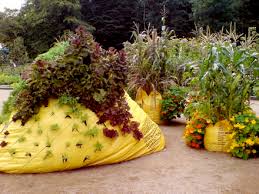
We're enduring a small spate of seasonal weather here in Austin, so I can't do anything about this idea right now except record it--but I've just found my next post-bucket experiment, and I can't wait! Hardly revolutionary, nothing more than a small tweak, really, but if it works...
1) Choose a compostable bag* suitably sized for a determined garden space.
If you're a small-space gardener, that may well be a doubled grocery bag; folks with room for larger raised beds could use leaf and lawn bags or those canvas sacks used for coffee beans and other staples. Not sure about compostable plastics, but it might be worth a try.
2) Combine well-cured bokashi, dried leaves or shredded paper, and soil or a soil-based potting mix in the bag. Close and set in place. (If using a grocery bag, roll top down, then wrap bag with twine and tie, and placed with the rolled side down.) No need to clear the ground first, though if your greenery is especially vigorous, a layer of cardboard or several newspapers might not be a bad idea.
3) Secure and let sit the requisite two weeks? (There's a testable variable! But, sure, why not. Allows for starting some seedlings or a trip to the nursery.) Then,
4) Using a spade or shears, cut V-shaped holes into the top of the bag. Into each hole, insert a spadeful of best-quality potting mix and a transplant. Olla pot(s), if using, should be placed now, too. The garden bag having been planted, it should be treated as appropriate for the region and conditions. And finally,
5) Repeat when your next bucket's cured.
It's the Add-a-Bead model of gardening: Find a spot, plunk down a bag, go on your merry way. Come back in a fortnight to plant the bag-in-place and set another beside it. Continue until all the world's a garden. ...yeah, okay, maybe not. But every time I help build a raised bed, I'm surprised at how much dirt it takes. This way, you could start with such soil as you had and acquire more as the situation permits.
Will this
work? No reason why not, though there are several variables to be tested. Is it worth collecting paper bags if you're not a slightly obsessed bokashi-er? I think so, though, again, this is as yet only a rainy-
dayweek's dream.
Like planter-finishing, this does require messing around with the cured bokashi, though only once. (Oh, joy: another test! Using disposable liners here.) Still, it's not like dumping a bucket into a bag of leaves is all that difficult. Bags do mean less time-in-sight than with planter-finishing, and using the bag as a planter means less mucking about with soils, too. It's altogether a neat--pun intended--solution to the eternal question of post-bucket protocols.
With free or repurposed bags, plus dried leaves and shredded paper, this can greatly reduce the expense of creating a raised bed, and allow for that cost, as well as the physical labor, to be spread out over time. Not to mention keeping that carbon-source out of the landfill where it does no one any good at all. (Hey, it's phone book season again! Home delivery of entirely useless but easily compostable pages. Yippee?)
How much dirt to add? Well, ideally there'd be at least three inches of soil on what will be the top of the bag when it's placed--once you've got that, then for the rest, I'd probably start with my usual one cup per half-gallon of bokashi, plus an additional half-gallon of dried leaves or quart of shredded paper. I've found that to work quite well in producing slow composts and worm-food. More dirt won't hurt a thing, it's just the most expensive ingredient in that mix, so I tend to ration it. Put it up top, where it'll do the most good, and let the organics break down below. Though there are limits; I seem to recall the lasagne garden people citing six inches as the maximum between soil layers, and while this wouldn't be a pure compost layer, that's not an unreasonable place to start.
Not that it's an issue with grocery bags, but there's always the chance someone will fall for my reverse fence-painting line. "Hey, you know what'd be fun? I could come install a raised-bed garden on your property?" -G-
And, oh!, think of what a demonstration garden this might make. If it works, it's simple enough for kindergarten classes.
Step right up and take a look at The Clean Your Plate Garden. So easy, even five-year-olds can do it! How's
that for a pitch?
DSF
*No, the photo's not of a compostable bag. That's a "construction debris bag," as featured in a story a couple of years back on TreeHugger and
GroovyGreen. And if I can get my hands on something in that line, or a more common landscape cloth bag, I'll certainly extend the test.







